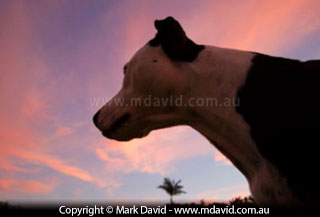
You don’t have to limit your sunset shots to only being about the sunset. Here’s how you can light up the stuff in the foreground.

The easy way
Taking a photo of a sunset is as easy as switching to shutter speed priority (about 150th or 200th second), aiming at the sky and pressing the shutter button. I describe that better here. With a shot like that, the sky comes out looking great and everything else, with the sky behind it, comes out black.
But what if you want to see the stuff in the foreground? Sometimes you don’t want it to be a silhouette. To get around that problem, I like to use my external flash. Just turn it on, crank down the power a little (if the foreground subject is right up close to the lens like this dog was) and take your shot.
Take a test shot and see if the foreground subject turned out too okay. If it it’s too bright then turn the flash’s power down a stop or two. I find that my best sunset shots are taken with a wide-angle lens, which means that I tend to get right up close to my foreground subject. That makes it even more likely that I’ll need to turn the power down on my flash.


Without the use of a flash, the foreground subject will most likely come out very dark. That might be what you want, though. The important thing is that you get to decide.
The not-so-easy way
If you tried all that and it didn’t come out right, then here’s what you’re going to have to do:
- In shutter speed priority mode, select 200th second and take a picture of the most colourful part of the sky by aiming at the sky. The background should now work out right.
- See what aperture and ISO settings your camera used to get that exposure, because you’re going to use them again in the next step.
- Switch to manual mode and select those exact same shutter speed (200th second), aperture and ISO settings. So now your sky is going to turn out right.
- Use your external flash and take a test shot to see how bright you need to make it.
- Adjust the flash’s power up or down according to what your test shot tells you.
- Take your shot
Matching the colours
If you want, you can put some warming gel (an orange-tinted plastic film) over your flash to give your flash light the same kind of warmth as the background colours. That will certainly make it look more natural.








